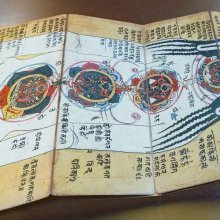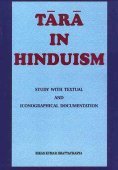Kundalini, Kuṇḍalinī, Kundalinī, Kumdalini: 16 definitions
Introduction:
Kundalini means something in Buddhism, Pali, Hinduism, Sanskrit, Hindi, biology. If you want to know the exact meaning, history, etymology or English translation of this term then check out the descriptions on this page. Add your comment or reference to a book if you want to contribute to this summary article.
Images (photo gallery)
In Hinduism
Yoga (school of philosophy)
Source: WikiPedia: YogaKundalini literally means coiled. In yoga, a “corporeal energy”—an unconscious, instinctive or libidinal force or Shakti, lies coiled at the base of the spine. It is envisioned either as a goddess or else as a sleeping serpent, hence a number of English renderings of the term such as ‘serpent power’. The kundalini resides in the sacrum bone in three and a half coils and has been described as a residual power of pure desire.
Source: DSpace at Pondicherry: Siddha Cult in Tamilnadu (yoga)Kuṇḍalini (कुण्डलिनि).—Siddha Pāmbāṭṭi, one of the most celebrated Tamil siddha who largely deals with this Kuṇḍalini-yoga, refers the serpent to the Kuṇḍalini power, which passes one’s subtle body through six cakras. The serpent or Kuṇḍalini is also sometimes defined as ‘base fire’ (mūla kanal) in many of the Siddha’s songs.
Source: Manblunder: Theory And Practice of Kundalini MeditationKuṇḍalinī (कुण्डलिनी).—How importance kuṇḍalinī is in the path or liberation is explained in Haṭhayoga Pradīpaka in the chapter samādhi. “When kuṇḍalinī is awakened through various means, one enters into the state of samādhi automatically. The one, who knows the path abandons all actions when his prāṇa enters into suṣumna (technically speaking it is through citriṇi-nāḍi, which is the inner most nāḍi in suṣumna. He is liberated when kuṇḍalinī enters into sahasrāra.”

Yoga is originally considered a branch of Hindu philosophy (astika), but both ancient and modern Yoga combine the physical, mental and spiritual. Yoga teaches various physical techniques also known as āsanas (postures), used for various purposes (eg., meditation, contemplation, relaxation).
Ayurveda (science of life)
Rasashastra (Alchemy and Herbo-Mineral preparations)
Source: Google Books: The Alchemical BodyKuṇḍalinī (कुण्डलिनी):—In every human body, the female kuṇḍalinī serpent sleeps coiled in the place of the “fire of time” (kālāgni)? with her mouth closed over an internal liṅga in the lower abdomen. It is only in the body of a yogin that she is ever awakened, and her awakening corresponds precisely to the initiation of the yogin’s progressive withdrawal into total yogic integration (samādhi) or fluid equilibrium (samarasa). On a more concrete level, it is the rise of the kuṇḍalinī that brings about the transmutation of raw semen into nectar in the cranial vault, a locus associated with the ethereal goose (haṃsa).
The Kuṇḍalinī in the body of the yogin is an incarnation of the feminine in this tradition and thereby incarnates all the perils and joys that women can represent for men. She is divine energy (śakti) and female materiality (prakṛti), but she is also a tigress who can drain a man of all his energy and seed. She is twofold and also known by the name bhogavatī.
It is when her name is interpreted in terms of bhoga as pleasure that this female serpent’s twofold role is brought to the fore in the tantric context. The kuṇḍalinī as bhogavatī is a female who both takes pleasure and gives pleasure. In tantric metaphysics, it is the kuṇḍalinī’s coiled body itself that is the turning point between emanation and participation, emission and resorption.
Nighantu (Synonyms and Characteristics of Drugs and technical terms)
Source: WorldCat: Rāj nighaṇṭuKuṇḍalinī (कुण्डलिनी) is another name for Guḍūcī, a medicinal plant identified with Tinospora cordifolia (heart-leaved moonseed) from the Menispermaceae or “moonseed family” of flowering plants, according to verse 3.13-16 of the 13th-century Raj Nighantu or Rājanighaṇṭu. The third chapter (guḍūcyādi-varga) of this book contains climbers and creepers (vīrudh). Together with the names Kuṇḍalinī and Guḍūcī, there are a total of thirty Sanskrit synonyms identified for this plant.
Dietetics and Culinary Art (such as household cooking)
Source: Shodhganga: Dietetics and culinary art in ancient and medieval IndiaKuṇḍalinī (कुण्डलिनी) refers to a type of sweet dish, as described as described in the 17th century Bhojanakutūhala (dravyaguṇāguṇa-kathana), and is commonly found in literature dealing with the topics of dietetics and culinary art, also known as Pākaśāstra or Pākakalā.
(Ingredients of Kuṇḍalinī): samita, curd, sugar, ghee and camphor.
(Cooking instructions): Smear the interiors of a new earthen pot with half prastha (384gm) of sour curd. Mix two prasthas (1Kg.536gm) of samita, one prastha (768gm)of sour curd and half a cup of sugar together in this pot. Place the pot in sunlight until the contents turn sour. Ghee is heated in another vessel. Place a single holed vessel on the top of this heating vessel. Pour the mixture of the earthen pot into the holed vessel. Rotate the single holed vessel in such a way that the mixture is falling into heated ghee. This process is repeated such that the contents of the mixture are fallen to the ghee to form circular shapes. After frying these circular shaped objects are taken from the ghee. Immerse them in sugar syrup. Add camphor and other fragrant items. After keeping them in the sugary syrup for a while, take them out. This preparation is called kuṇḍalinī. The same preparation, if fashioned to ball- like shapes is called dadhivaṭi.

Āyurveda (आयुर्वेद, ayurveda) is a branch of Indian science dealing with medicine, herbalism, taxology, anatomy, surgery, alchemy and related topics. Traditional practice of Āyurveda in ancient India dates back to at least the first millenium BC. Literature is commonly written in Sanskrit using various poetic metres.
Shaktism (Shakta philosophy)
Source: DSpace at Pondicherry: Siddha Cult in Tamilnadu (shaktism)Kuṇḍalini (कुण्डलिनि) is the energy in the form of a coiled serpent remaining latent in the mūlādhārā. As the source of all energy, kuṇḍalini reveals itself when roused by yogic exercise. This ancient belief is at the root of the concept of Kāyasādhanā, so much emphasised in the Śākta and the Buddhist Tantras.
The highest cerebral region is known as sahasrāra. Through yogic exercise this kuṇḍalini-śakti has to be pushed up through the two main nerves, iḍa and piṅgala, so that it may reach the sahasrara or the highest cerebral region where it should meet its source. Then the nectar which reached the sahasrāra is consumed by the yōgic practitioner forms the final stage of this kuṇḍalini-yoga.
Source: academia.edu: The Śāradātilakatantra on YogaKuṇḍalinī (कुण्डलिनी) is explained in terms of kuṇḍalinīyoga by Lakṣmaṇadeśika in his 11th-century Śaradātilaka 25.64-65.—“(64) One should think of this kuṇḍalī, the chief queen of the great serpent awake in the root [cakra], as moving in the suṣumṇā, as quickly piercing through the group of ādhāras like a blazing lightning [bolt], as worshipping [her] husband with streams of divine nectar flowing from the lunar disc located in the etheric lotus, [and] as returning to [her] house. (65) Śakti, the kuṇḍalinī, the mother of all, should be meditated upon as emerging from her own [i.e.mūla]-ādhāra, and as having taken in hand that haṃsaḥ, which is eternal, infinite [and] of imperishable qualities, [and then] going to Śaṃbhu’s [i.e.Śiva’s] residence, [and] after herself experiencing supreme bliss with him, returning to her own abode [i.e. the mūlādhāra]–she who has the lustre of ten million suns [and] who beguiles the world.”
Note: The kuṇḍalī or kuṇḍalinī (derived from the word kuṇḍala–“a ring, coil”) is energy in the form of a coiled serpent.

Shakta (शाक्त, śākta) or Shaktism (śāktism) represents a tradition of Hinduism where the Goddess (Devi) is revered and worshipped. Shakta literature includes a range of scriptures, including various Agamas and Tantras, although its roots may be traced back to the Vedas.
Shilpashastra (iconography)
Source: DSpace at Pondicherry: Siddha Cult in Tamilnadu (sculpture)Kuṇḍalini (कुण्डलिनि).—In the Ādikeśava Perumal temple at Tiruvaṭṭāṛu in Kaṉṇiyākumari district of Tamiḻnādu, there are several interesting sculptures showing the Kuṇḍalini aspects. In one of the sculptures, a yogic practitioner is shown with a snake beside him as climbing up. It denotes that the yogi’s practice of kuṇḍalini-yoga is in a progressive stage.
Above his head a four petalled lotus is depicted which is denoting that he is in initial stage of practising kuṇḍalini from mūlādhāra (in the symbolic form of four petalled lotus).

Shilpashastra (शिल्पशास्त्र, śilpaśāstra) represents the ancient Indian science (shastra) of creative arts (shilpa) such as sculpture, iconography and painting. Closely related to Vastushastra (architecture), they often share the same literature.
General definition (in Hinduism)
Source: Hindupedia: Advayataraka UpaniṣadThe Kuṇdalinī (कुण्डलिनी) which is fine like the thread in the lotus stalk, is inside this suṣumnā and is shining like millions of lightnings. By closing the ears and meditating on the sound within and the blue light between the eyes, and witnessing it, one gets infinite happiness. This is meditation from ‘inside.’
In Buddhism
Theravada (major branch of Buddhism)
Source: Pali Kanon: Pali Proper NamesThe name given to the offspring of the sarika(myna)-bird in the Tesakuna Jataka. She is identified with Uppalavanna. J.v.125.
Theravāda is a major branch of Buddhism having the the Pali canon (tipitaka) as their canonical literature, which includes the vinaya-pitaka (monastic rules), the sutta-pitaka (Buddhist sermons) and the abhidhamma-pitaka (philosophy and psychology).
Tibetan Buddhism (Vajrayana or tantric Buddhism)
Source: OSU Press: Cakrasamvara SamadhiKuṇḍalinī (कुण्डलिनी) or Kuṇḍalinīyoga refers to breathing exercises (for generating internal heat originating from the pelvic bowl), according to the Anuttarayoga Tantra divisions of Mahāyāna-Vajrayāna Buddhism, according to Buddhist teachings followed by the Newah in Nepal, Kathmandu Valley (whose roots can be traced to the Licchavi period, 300-879 CE).—What makes Anuttara Yoga unique is the nature of the deities visualized, wrathful and erotic, and the level of sophistication of the meditative practices which include caṇḍalī-yoga, "yogic heat", known as "Tummo" in Tibetan, which are breathing exercises using kuṇḍalinī-yoga for generating internal heat originating from the pelvic bowl, utkrānti-yoga, "death yoga", known as "Phowa" in Tibetan, which is transference of consciousness at the time of death, and śmāśāna-yoga, "cremation ground yoga", meditations and ritual magic performed in cremation grounds.

Tibetan Buddhism includes schools such as Nyingma, Kadampa, Kagyu and Gelug. Their primary canon of literature is divided in two broad categories: The Kangyur, which consists of Buddha’s words, and the Tengyur, which includes commentaries from various sources. Esotericism and tantra techniques (vajrayāna) are collected indepently.
Biology (plants and animals)
Source: Wisdom Library: Local Names of Plants and DrugsKundalini [କୁଣ୍ଡଳିନୀ] in the Odia language is the name of a plant identified with Tinospora cordifolia from the Menispermaceae (Moonseed) family. For the possible medicinal usage of kundalini, you can check this page for potential sources and references, although be aware that any some or none of the side-effects may not be mentioned here, wether they be harmful or beneficial to health.
Kundalini [कुण्डलिनी] in the Sanskrit language, ibid. previous identification.

This sections includes definitions from the five kingdoms of living things: Animals, Plants, Fungi, Protists and Monera. It will include both the official binomial nomenclature (scientific names usually in Latin) as well as regional spellings and variants.
Languages of India and abroad
Sanskrit dictionary
Source: Cologne Digital Sanskrit Dictionaries: Monier-Williams Sanskrit-English Dictionary1) Kuṇḍalinī (कुण्डलिनी):—[from kuṇḍalin > kuṇḍala] f. the plant Coccus cordifolius, [cf. Lexicographers, esp. such as amarasiṃha, halāyudha, hemacandra, etc.]
2) [v.s. ...] a particular dish (curds boiled with ghee and rice), [Bhāvaprakāśa]
3) [v.s. ...] a Śakti or form of Durgā.
Sanskrit, also spelled संस्कृतम् (saṃskṛtam), is an ancient language of India commonly seen as the grandmother of the Indo-European language family (even English!). Closely allied with Prakrit and Pali, Sanskrit is more exhaustive in both grammar and terms and has the most extensive collection of literature in the world, greatly surpassing its sister-languages Greek and Latin.
Hindi dictionary
Source: DDSA: A practical Hindi-English dictionaryKundalini in Hindi refers in English to:—(nf) the serpent force of the hathyogi:..—kundalini (कुंडलिनी) is alternatively transliterated as Kuṃḍalinī.
...
Kannada-English dictionary
Source: Alar: Kannada-English corpusKuṃḍalini (ಕುಂಡಲಿನಿ):—[noun] (myst.) the cosmic power latent at the base of the physical system of human beings, in the form of microcosm which, when awakened by yogic methods, proceeds upward through different planes of consciousness, rendering each of them dynamic and make the individual possess, and be possessed by, the universal consciousness.
Kannada is a Dravidian language (as opposed to the Indo-European language family) mainly spoken in the southwestern region of India.
See also (Relevant definitions)
Starts with: Kumdalinicalana, Kundalini Panha, Kundalini Yoga, Kundalinipada, Kundalinirupa, Kundalinishakti, Kundaliniyoga.
Ends with: Kulakundalini, Pranakundalini, Shaktakundalini, Urdhvakundalini, Yogakundalini.
Full-text (+459): Sushumna, Kumdalishakti, Kumdalini, Amritakundali, Urdhva, Kundalini Yoga, Bindu, Kundalini Panha, Sahasrara, Sarpa, Mamuni, Pranayama, Yogakundalini, Kukkutasana, Calayitva, Kulakundalini, Shaktipata, Highest power, Shakti-chalana, Bodhayitva.
Relevant text
Search found 36 books and stories containing Kundalini, Kuṇḍalinī, Kundalinī, Kuṇḍalini, Kumdalini, Kuṃḍalini; (plurals include: Kundalinis, Kuṇḍalinīs, Kundalinīs, Kuṇḍalinis, Kumdalinis, Kuṃḍalinis). You can also click to the full overview containing English textual excerpts. Below are direct links for the most relevant articles:
Thirty minor Upanishads (by K. Narayanasvami Aiyar)
Yoga-kundalini Upanishad of Krishna-Yajurveda, Chapter I
Yoga-kundalini Upanishad of Krishna-Yajurveda, Chapter II
The Devi Bhagavata Purana (by Swami Vijñanananda)
Chapter 8 - On Bhūta Śuddhi < [Book 11]
Chapter 40 - The External Worship of the Devī < [Book 7]
Chapter 1 - On what is to be thought of in the morning < [Book 11]
Jnaneshwari (Bhavartha Dipika) (by Ramchandra Keshav Bhagwat)
Verse 18.52 < [Chapter 18 - Moksha-sannyasa-yoga]
Verse 6.14 < [Chapter 6 - Dhyana-yoga]
Verse 6.15 < [Chapter 6 - Dhyana-yoga]
Shat-cakra-nirupana (the six bodily centres) (by Arthur Avalon)
Cidgaganacandrika (study) (by S. Mahalakshmi)
Verse 7 [Rudra is Manthāna Bhairava] < [Chapter 1 - First Vimarśa]
Verse 96 [Praṇava produced by Cakrapañcaka in Kuṇḍalinī] < [Chapter 3 - Third Vimarśa]
Verse 123 [Khecarī attains Śambhupada through Suṣumnā-nāḍi] < [Chapter 3 - Third Vimarśa]
Varahi Tantra (English Study) (by Roberta Pamio)
Chapter 27 - The exposition on Mudrās and Bandhas < [Summary of the Vārāhī Tantra]
Chapter 26 - Haṭhayoga (according to the Haṭhayogapradīpikā) < [Summary of the Vārāhī Tantra]
Chapter 17 - The Āmnāyas (traditions), Continued < [Summary of the Vārāhī Tantra]
Related products



